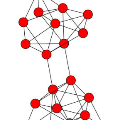Representation learning of networks via embeddings has garnered popularity and has witnessed significant progress recently. Such representations have been effectively used for classic network-based machine learning tasks like link prediction, community detection, and network alignment. However, most existing network embedding techniques largely focus on developing distributed representations for traditional flat networks and are unable to capture representations for multilayer networks. Large scale networks such as social networks and human brain tissue networks, for instance, can be effectively captured in multiple layers. In this work, we propose Multi-Net a fast and scalable embedding technique for multilayer networks. Our work adds a new wrinkle to the the recently introduced family of network embeddings like node2vec, LINE, DeepWalk, SIGNet, sub2vec, graph2vec, and OhmNet. We demonstrate the usability of Multi-Net by leveraging it to reconstruct the friends and followers network on Twitter using network layers mined from the body of tweets, like mentions network and the retweet network. This is the Work-in-progress paper and our preliminary contribution for multilayer network embeddings.
翻译:通过嵌入式网络进行代表性学习已获得广泛支持,最近也取得了显著进展。这种介绍被有效地用于传统的基于网络的机器学习任务,如链接预测、社区检测和网络协调。然而,大多数现有的嵌入式网络技术主要侧重于为传统平板网络建立分布式代表,无法为多层网络提供代表。例如,社交网络和人脑组织网络等大型网络可以在多层中有效被捕捉。在这项工作中,我们提议多层网络采用快速和可扩展的嵌入技术。我们的工作为最近推出的网络嵌入式家庭增加了一个新的皱纹,例如节点2c、LINE、DeepWalk、Signet、子2vec、图示2vec和 OhmNet。我们通过利用多层网络,利用从推文体中提取的网络层,例如提及网络和retweet网络,来重建Twitter上的朋友和追随者网络。这是工作进展文件,以及我们对多层网络嵌入的初步贡献。


